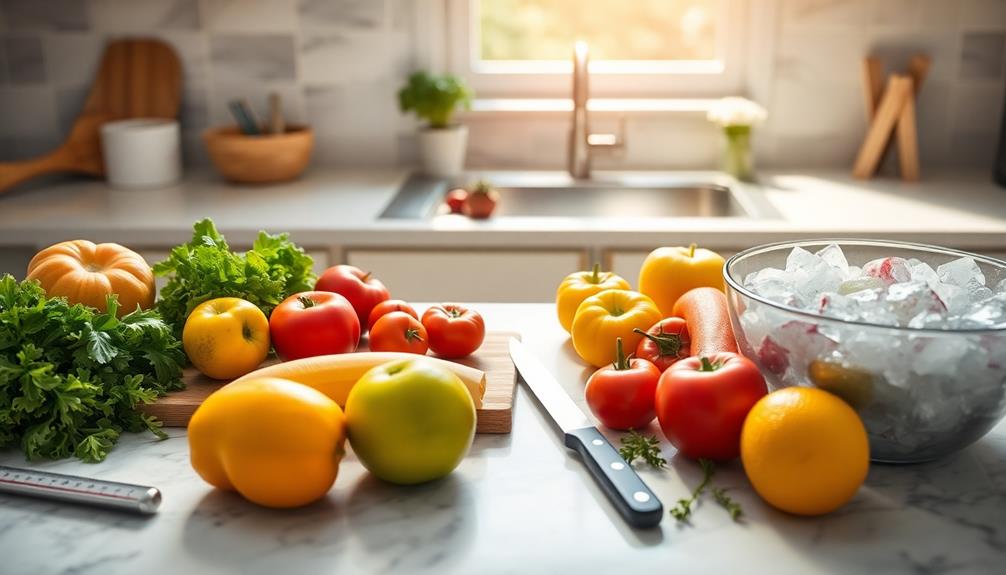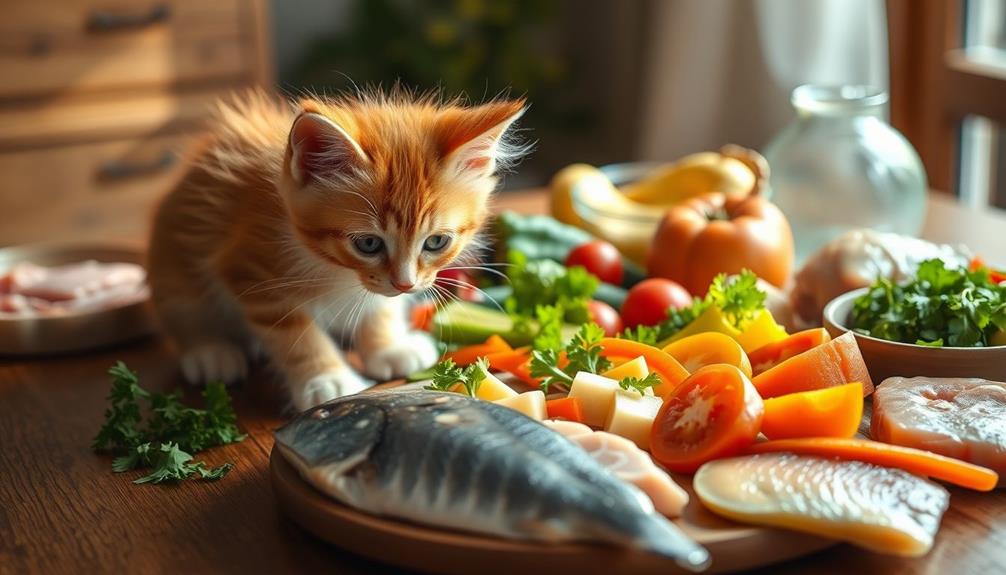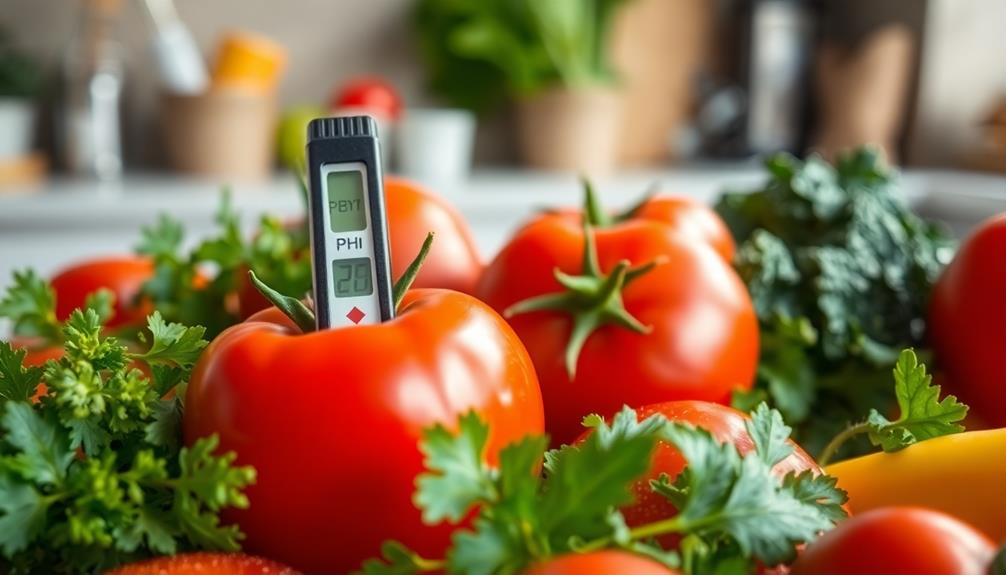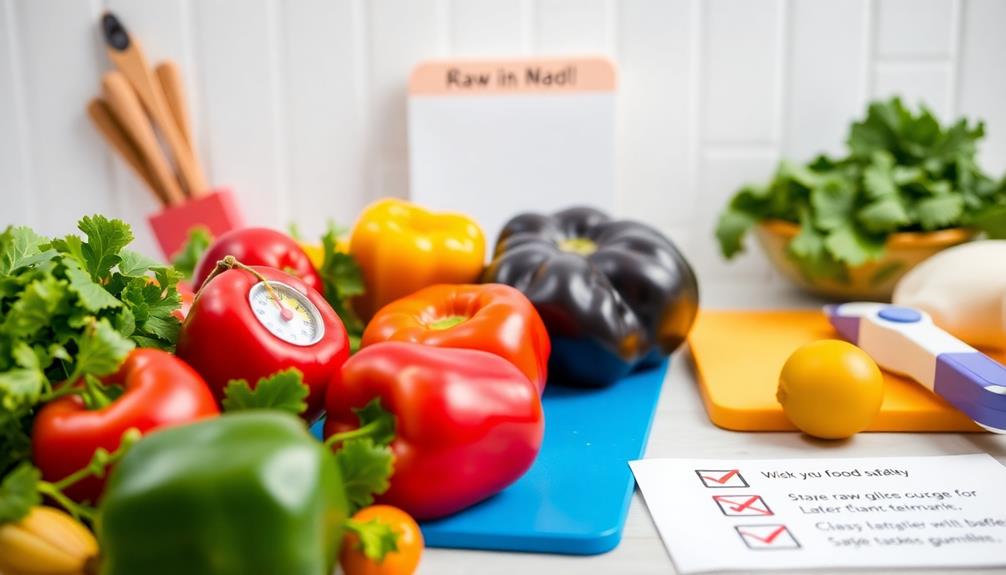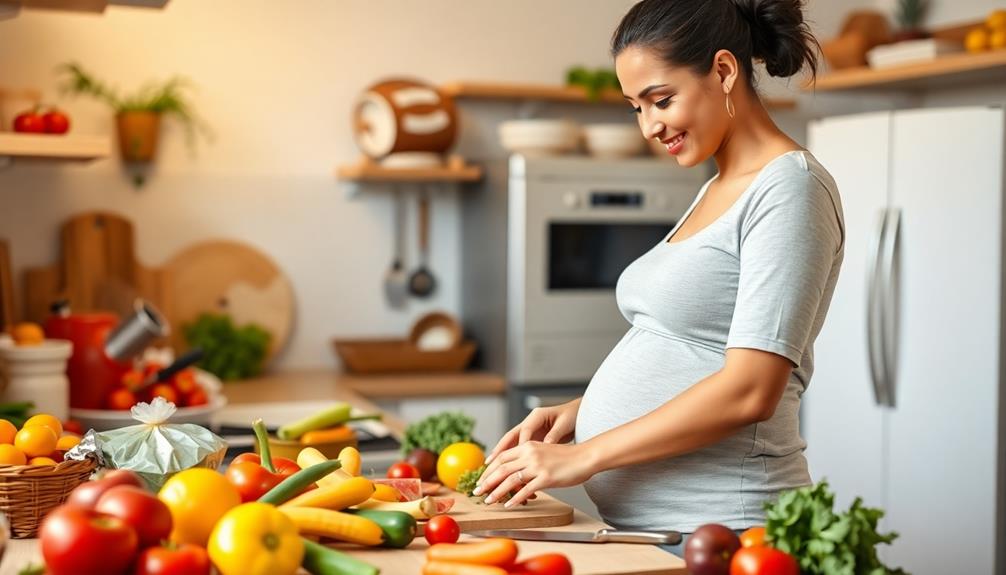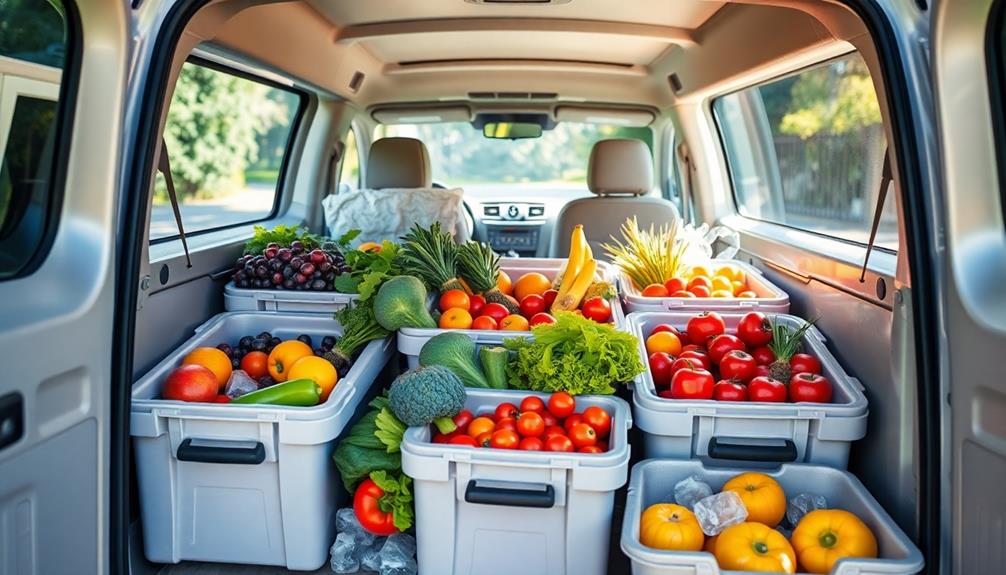Ensuring raw food safety is crucial for preventing foodborne illnesses in your kitchen. Start by keeping everything clean; wash your hands and sanitize surfaces often. Always separate raw meats from ready-to-eat foods to avoid cross-contamination. When cooking, aim for safe internal temperatures—165°F for poultry and 145°F for other meats. Keep your refrigerator below 40°F to slow bacterial growth and store raw foods in their own containers. Use proper defrosting methods and avoid refreezing thawed raw items. Mastering these essential guidelines can enhance your confidence in handling raw ingredients. Stick around to discover even more tips for safe food preparation!
Key Takeaways
- Always wash hands and sanitize surfaces before and after handling raw foods to eliminate bacteria.
- Use separate cutting boards for raw meats and ready-to-eat foods to prevent cross-contamination.
- Store raw foods in containers and keep refrigerators at or below 40°F to inhibit bacterial growth.
- Use a food thermometer to ensure cooked foods reach safe internal temperatures for consumption.
- Follow safe defrosting methods, such as using the refrigerator, to minimize food safety risks.
Understanding Food Safety Concerns
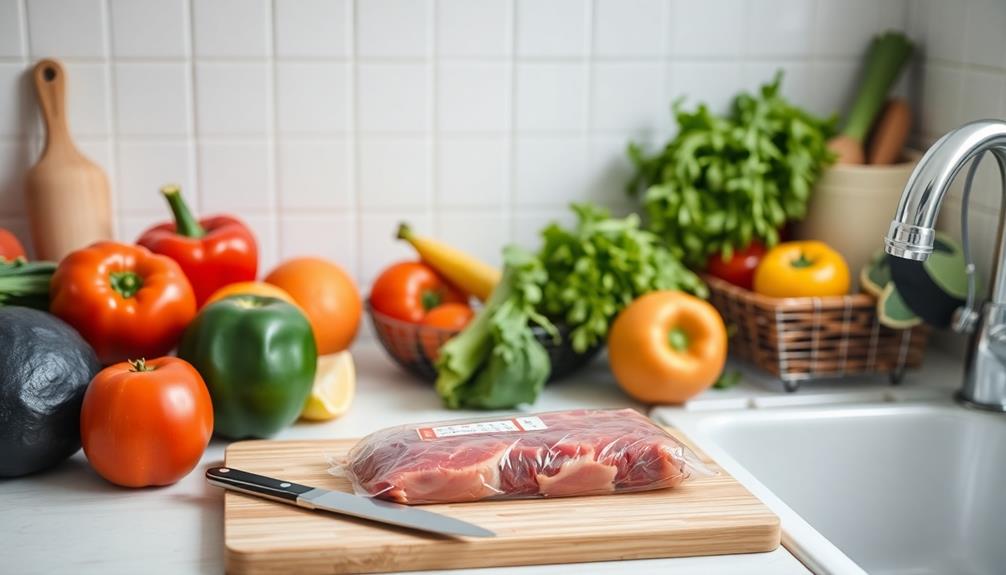
Food safety concerns are often amplified by high-profile recalls and E. coli outbreaks, creating anxiety for many consumers. When it comes to raw food, you might worry about bacteria lurking in your ingredients.
It's essential to understand that foodborne illnesses can affect anyone, but at-risk populations like the elderly and pregnant women need extra precautions. Additionally, understanding the potential benefits of a raw food diet, such as increased energy and improved digestion, can help you appreciate the positive aspects of incorporating raw foods into your meals while being mindful of safety.
To minimize risks, you should familiarize yourself with important safety tips and proper handling practices. Always wash your hands and surfaces before preparing food, and verify your ingredients are sourced responsibly.
Remember the four core principles: clean, separate, cook, and chill.
You might think, "When you don't know, you throw," but this mindset can lead to unnecessary food waste and fear. Instead, educate yourself about ingredient storage and cooking techniques. By understanding and implementing these practices, you can greatly reduce your anxiety about food safety.
Being proactive not only protects your health but also boosts your confidence in the kitchen. With the right knowledge, you can enjoy raw food without compromising your safety or the well-being of those around you.
Key Principles of Food Safety
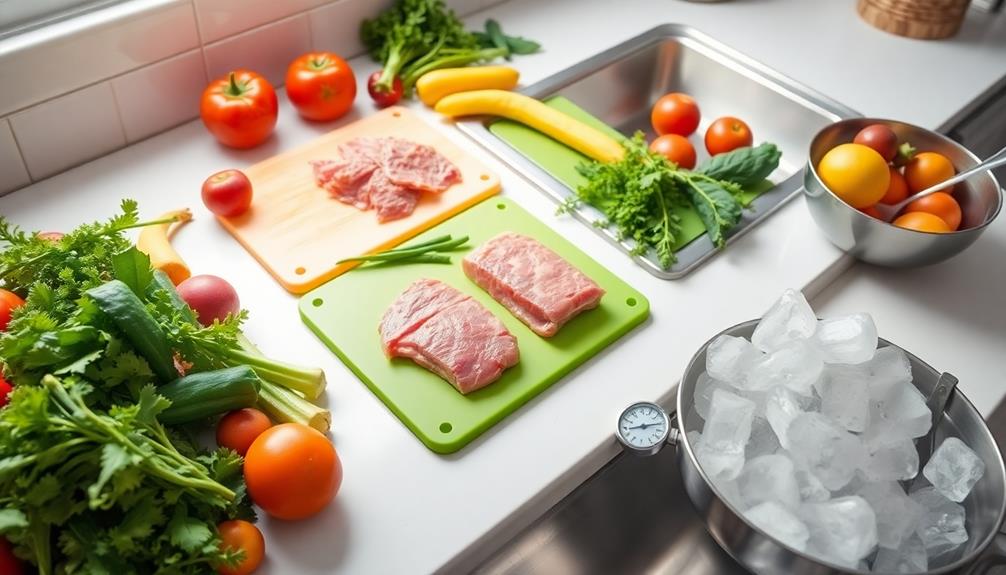
When preparing meals, understanding the key principles of food safety is crucial for preventing foodborne illnesses. By following these principles, you can greatly reduce the risk of harmful bacteria and guarantee your meals are safe to eat. Here are the four key principles to keep in mind:
1. Clean: Always wash your hands with warm, soapy water before, during, and after food preparation. Regularly sanitize kitchen surfaces to eliminate any bacteria that may be present.
Additionally, maintaining a clean environment helps to improve overall air quality, which is beneficial when using appliances like air purifiers to keep your kitchen fresh and free from airborne contaminants air purifier maintenance dos.
2. Separate: Use separate cutting boards and utensils for raw meat, poultry, and seafood. This helps prevent cross-contamination with ready-to-eat foods, keeping your meals safe.
3. Cook: Make sure to cook food to the appropriate internal temperatures—165°F for poultry and 145°F for whole cuts of meat. Cooking food thoroughly kills any harmful bacteria that may be lurking.
4. Chill: Keep food out of the danger zone (40°F to 140°F) where bacteria can multiply rapidly. Refrigerate leftovers promptly and guarantee your fridge maintains a safe temperature.
Safe Food Handling Practices
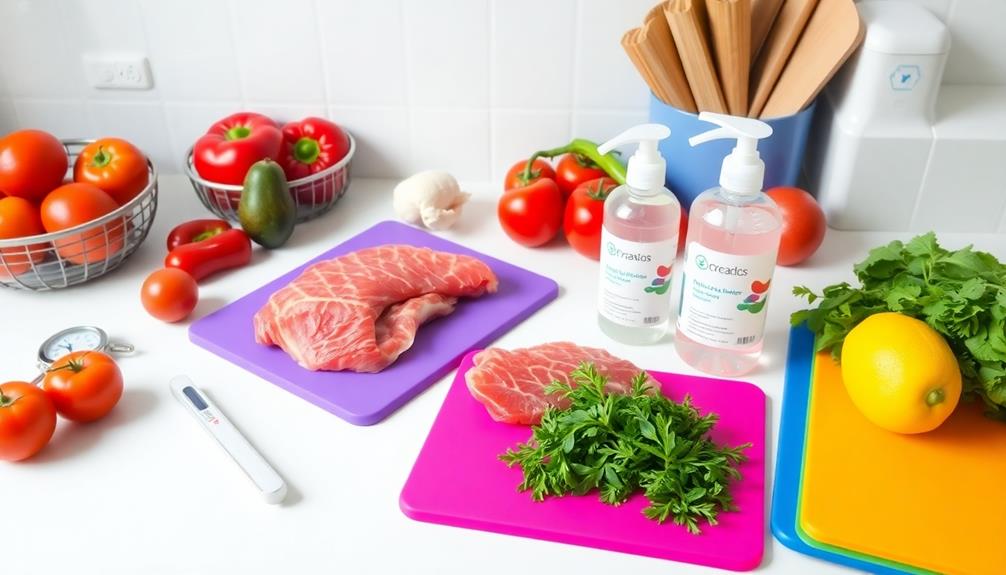
To keep your food safe, hand hygiene is essential. Always wash your hands thoroughly before and after handling food to reduce the risk of spreading bacteria.
Additionally, using separate cutting boards for raw meats and ready-to-eat foods can help prevent cross-contamination in your kitchen.
Importance of Hand Hygiene
Effective hand hygiene is essential for ensuring safe food preparation and preventing foodborne illnesses. By consistently washing your hands, you can greatly reduce the risk of transferring harmful bacteria to your food.
Here are some key practices to follow:
- Wash hands before, during, and after food handling, especially after touching raw meat, poultry, or fish. This helps prevent cross-contamination.
- Use warm, soapy water for at least 20 seconds to thoroughly clean your hands. Don't forget to scrub between your fingers and under your nails.
- Hand sanitizers can be helpful, but they shouldn't replace washing hands when they're visibly dirty or greasy. Choose sanitizers with at least 60% alcohol for effectiveness.
- Always wash hands after handling pets, using the restroom, or touching surfaces that might harbor germs. These actions can introduce pathogens into your food.
Additionally, keeping nails short and avoiding jewelry can further minimize the risk of bacteria harboring on your hands during food preparation.
Preventing Cross-Contamination Risks
Preventing cross-contamination is vital for maintaining food safety in your kitchen. Start by using separate cutting boards for raw meat, poultry, and fish. This practice stops juices from contaminating ready-to-eat foods. After each use, make sure to clean and sanitize these boards thoroughly.
Additionally, proper handwashing practices can greatly reduce the risk of transferring harmful pathogens, which is particularly important when preparing a raw food diet.
Store raw meats on the bottom shelves of your refrigerator to prevent any drips from contaminating other foods. Keep them tightly wrapped to avoid cross-contamination.
Never reuse plates that held raw meat for cooked foods without proper cleaning and sanitization; this is essential to eliminate any residual bacteria.
Always wash your hands with warm, soapy water for at least 20 seconds before and after handling raw foods. This simple step greatly reduces the risk of transferring harmful pathogens.
Best Storage and Serving Methods
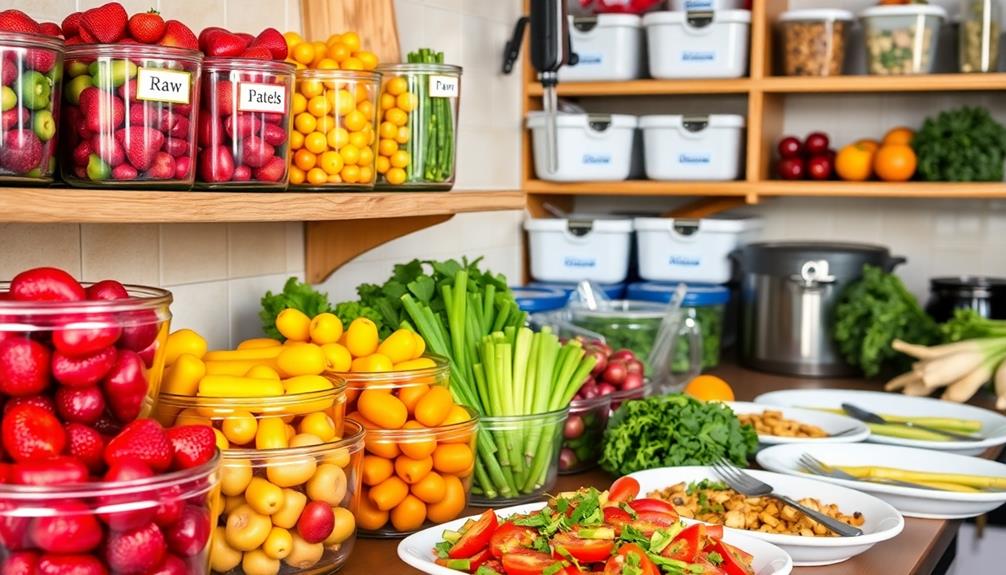
Properly storing and serving raw foods is essential for maintaining their safety and freshness. To guarantee food safety, follow these best practices:
- Separate Containers: Store raw foods in separate containers to prevent cross-contamination. Always place raw meats on the lowest shelves of the refrigerator to avoid drips onto other foods.
- Refrigerator Temperatures: Keep your refrigerator at 40°F or below. This helps inhibit bacterial growth, assuring your raw foods remain safe for consumption.
- Check Expiration Dates: Always check the expiration dates on packaging and follow the storage instructions. This certifies that your raw foods stay fresh and safe.
- Serving Raw Foods: When serving raw foods, keep them chilled and limit exposure to room temperature to no more than two hours, especially in warmer conditions.
Defrosting and Re-freezing Tips
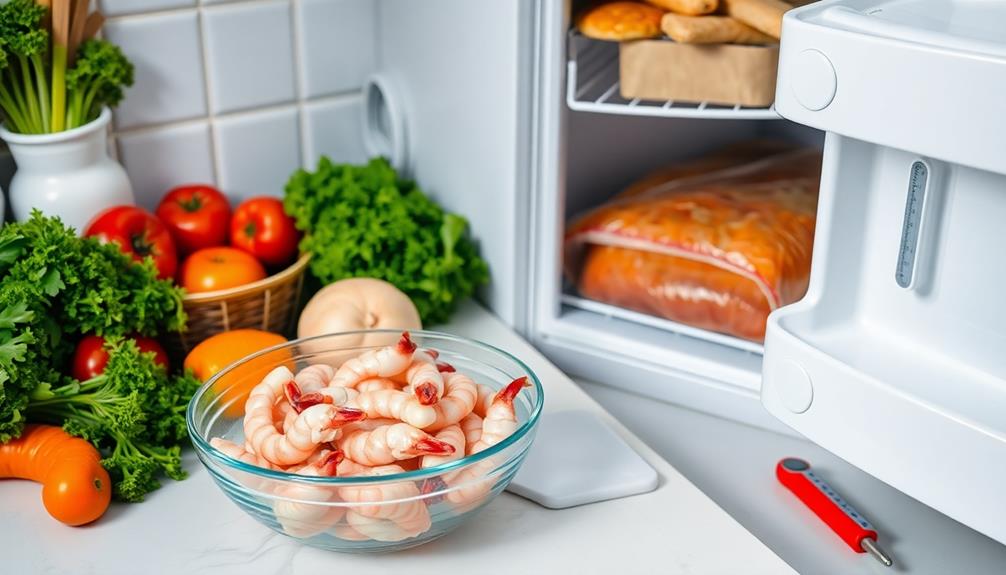
When it comes to defrosting, always use the refrigerator or microwave, never room temperature, to keep your food safe.
Remember, you shouldn't refreeze raw meat, fish, or poultry after thawing, but cooked items can be refrozen if handled properly.
Let's explore these safe defrosting methods and the guidelines for refreezing to keep your meals free from foodborne illness.
Safe Defrosting Methods
Safe defrosting methods are essential for maintaining food safety and preventing bacterial growth. When you thaw food improperly, like leaving it at room temperature, you risk allowing harmful bacteria to thrive in the danger zone (40°F – 140°F).
To guarantee you defrost safely, follow these guidelines:
- Refrigerator: Always defrost raw meat and fish in the refrigerator. This keeps the temperature safe and minimizes bacterial growth.
- Cold Running Water: If you need to defrost quickly, use a sealed container under cold running water. This method maintains a safe temperature.
- Microwave: You can use a microwave for defrosting, but remember to cook food immediately after. This guarantees any bacteria that may have developed are eliminated.
- 24-Hour Rule: Once defrosted, cook raw meat, fish, or poultry within 24 hours to minimize food safety risks.
Re-freezing Guidelines Explained
Understanding how to handle food after defrosting is essential for maintaining safety in your kitchen. When it comes to raw meat, fish, and poultry, never refreeze them after defrosting. This practice can lead to foodborne illnesses. However, you can refreeze cooked meat, fish, and poultry, as long as they've been cooled and stored promptly.
To guarantee food safety, follow these guidelines:
| Food Type | Refreezing Guidelines |
|---|---|
| Raw Meat, Fish, Poultry | Do NOT refreeze after thawing |
| Cooked Meat, Fish, Poultry | Can be refrozen if cooled properly |
| Thawed Foods (like ice cream) | Do NOT return to freezer |
| Limit Refreezing | Only once to minimize foodborne risk |
| Consumption Time | Cooked foods should be eaten within 24 hours |
Always use a food thermometer to check that your cooked foods reach safe temperatures. By following these re-freezing guidelines, you can protect yourself and your loved ones from foodborne illnesses while enjoying your meals safely.
Educational Resources for Food Safety
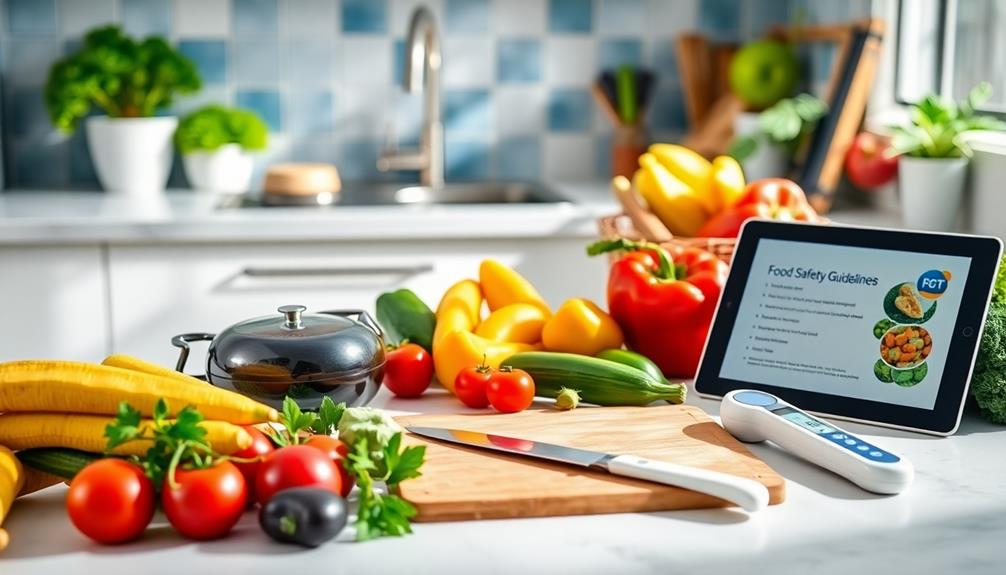
Steering through the world of food safety can feel overwhelming, but there are plenty of reliable resources at your fingertips. Utilizing these educational resources can help you understand safe food handling practices, reduce the risk of foodborne illnesses, and protect at-risk populations from harmful bacteria.
Here are four valuable resources you should consider:
- AskKaren.com – This site offers accurate and up-to-date food safety information, including answers to your specific questions.
- USDA Meat and Poultry Hotline – Call this hotline for expert guidance on food safety issues, especially when it comes to cooking meat and poultry.
- NHS Inform – Access thorough food safety advice, focusing on safe food handling and guidelines tailored for at-risk populations.
- Community Cooking Classes – Participate in local workshops that emphasize food safety education, enhancing your culinary skills while ensuring the food you prepare is safe.
Regularly checking for product recalls and understanding expiration dates is also essential.
Engaging with local health departments can provide additional support tailored to your community's specific needs.
Frequently Asked Questions
What Are the 5 Most Important Food Safety Guidelines?
To guarantee food safety, you should always clean your hands, separate raw meats from produce, cook food to proper temperatures, chill perishables promptly, and avoid cross-contamination by using distinct utensils and surfaces.
What Are the 7 Golden Rules for Safe Food Preparation?
When preparing food, you should clean, separate, cook, chill, avoid cross-contamination, store properly, and sanitize regularly. Following these seven golden rules guarantees your meals are safe, enjoyable, and free from harmful bacteria.
What Are Three 3 of the Essential Food Safety Practices for the Safe Handling of Raw Eggs and Egg Products?
When handling raw eggs, always refrigerate them below 40°F, cook until firm at 160°F, and use separate utensils to avoid cross-contamination. Remember to wash your hands and surfaces thoroughly afterward. Stay safe!
What Are the Guidelines for Food Preparation?
When it comes to food preparation, you've got to guarantee cleanliness. Wash your hands, use separate boards for raw meats, scrub produce, cook to safe temperatures, and refrigerate leftovers promptly to keep bacteria at bay.
Conclusion
In wrapping up your journey through raw food safety, remember that a little care goes a long way in keeping your meals fresh and delightful. By embracing safe handling practices and smart storage solutions, you're not just avoiding potential pitfalls; you're crafting a culinary experience that's both nourishing and enjoyable. So, roll up your sleeves and immerse yourself in the world of raw food with confidence, knowing you've got the tools to keep your kitchen thriving!

